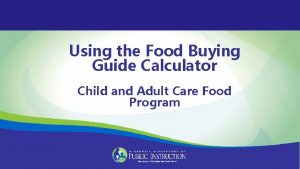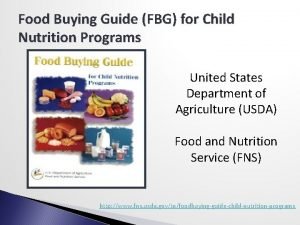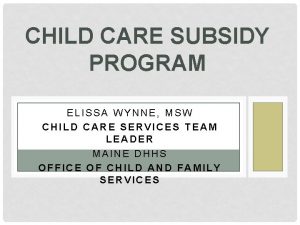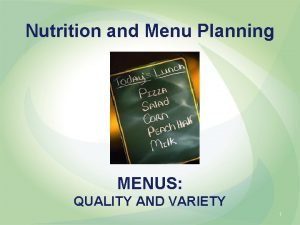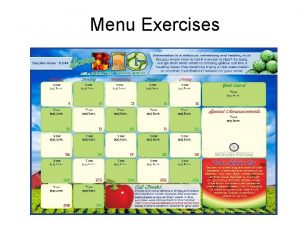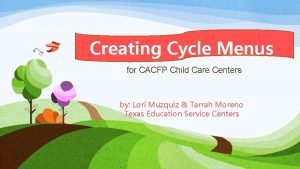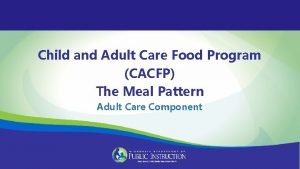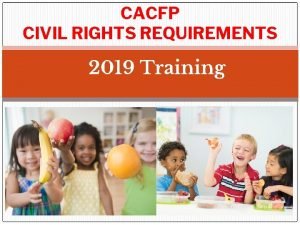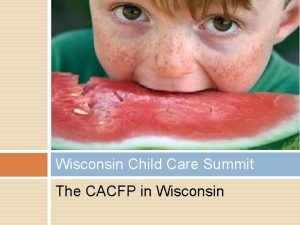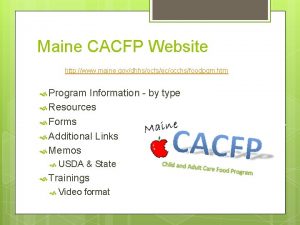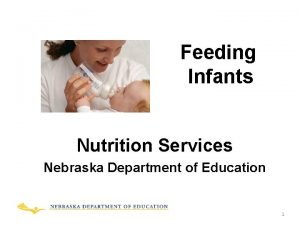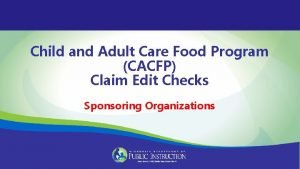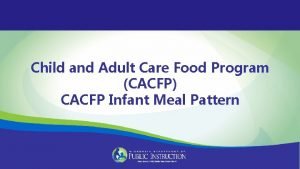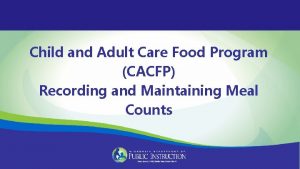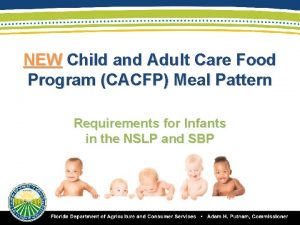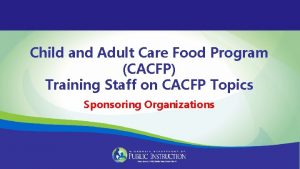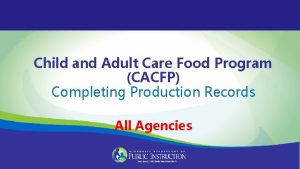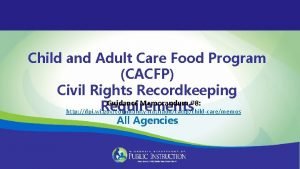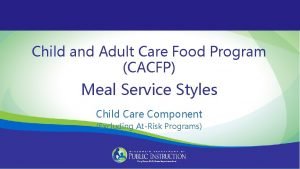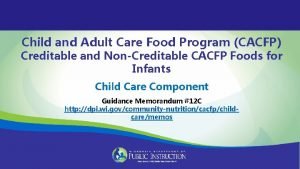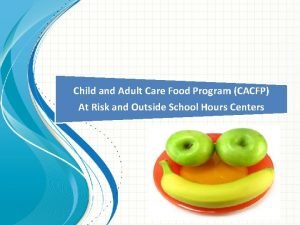Child and Adult Care Food Program CACFP Recording













- Slides: 13

Child and Adult Care Food Program (CACFP) Recording and Maintaining Meal Counts Three (3) or Less Meals

Meal Counts • Your agency is reimbursed for the number of meals and snacks it serves to CACFP enrolled children each day • Meal counts must be recorded daily at the time of each meal or snack service, or immediately after • This is called the Time of Service Meal Count

Daily Participation Record and Monthly Meal Count Summary Guidance Memorandum #9 C: Recordkeeping Requirements for the CACFP http: //dpi. wi. gov/community-nutrition/cacfp/child-care/memos

Time of Service Meal Count Procedure: Completing Meal Counts • Add up the number of children provided with a complete CACFP reimbursable meal or snack Total = 6 1 2 3 6 5 4

Time of Service Meal Count Procedure: Recording Meal Counts • • Record the number on the Daily Participation Record and Monthly Meal Count Summary form. Record under the correct meal/snack column and for Daily Participation Record and Monthly Meal Count Summary the correct day. Child and Adult Care Food Program (Child Care Component) Month ______October_____________ Date 1 2 3 4 5 6 7 8 9 10 Breakfast 5 3 5 6 A. M. Snack Lunch 6 5 6 Site/Classroom_3 Year Olds P. M. Snack 7 7 5 Supper Additional Snack

Time of Service Meal Count: Center Environment • Common Eating Area (1 Meal Count form for center) • Multiple Locations (1 Meal Count form for each group or class)

Time of Service Meal Counts: Who Will Complete? • Common Eating Area • Multiple Locations • Cook • Director • Lead Teacher • Teachers

Compiling Time of Service Meal Counts • At the end of the month, total the daily numbers within each column to get a grand total. Record this at the bottom of the form • • Include infant meal/snack totals at the bottom of the form if you claim infants (from Infant Meal Records) Date Breakfast A. M. Snack Lunch 6 28 5 29 Supper Additional Snack SUM of 1 st-26 th SUM of 1 st 26 th 27 P. M. Snack Attendance SUM of 1 st-26 th 5 8 4 7 7 4 5 6 7 30 6 6 6 31 Infant Meal Records/Total # of Reimbursable Meals* 4 5 8 45 52 43 66 TOTAL 165 0 187 188 0 0 208

Transfer Meal Counts to Claim Worksheet Date Breakfast A. M. Snack Lunch P. M. Snack TOTAL 165 0 187 188 Supper Additional Snack Attendance 0 0 208 Calculate average daily attendance (ADA) by dividing the total attendance by the number of service days Monthly Claim for Reimbursement

Meal Counts Cannot Be… • Based on computerized or manual attendance records • This does not meet the definition of a Time of Service Meal Count

Meal Counts Cannot Be… • Recorded based on the number of children expected to eat a meal or snack Example: The cook is provided with the number of children in attendance in the morning and is going to prepare the meal based this number. This number cannot be transferred to the meal count form for each meal or snack that day. Children do unexpectedly leave and/or arrive throughout the day, get sick, or decide they do not want to sit and eat a meal.

Adult Meals • Adults may eat meals and snacks with children; however, their meals and snacks cannot be claimed for reimbursement • Do not record adult meals or snacks on the Daily Participation and Monthly Meal Count Summary form

Non-Discrimination Statement (NDS) In accordance with Federal civil rights law and U. S. Department of Agriculture (USDA) civil rights regulations and policies, the USDA, its Agencies, offices, and employees, and institutions participating in or administering USDA programs are prohibited from discriminating based on race, color, national origin, sex, disability, age, or reprisal or retaliation for prior civil rights activity in any program or activity conducted or funded by USDA. Persons with disabilities who require alternative means of communication for program information (e. g. Braille, large print, audiotape, American Sign Language, etc. ), should contact the Agency (State or local) where they applied for benefits. Individuals who are deaf, hard of hearing or have speech disabilities may contact USDA through the Federal Relay Service at (800) 877 -8339. Additionally, program information may be made available in languages other than English. To file a program complaint of discrimination, complete the USDA Program Discrimination Complaint Form, (AD -3027) found online at: http: //www. ascr. usda. gov/complaint_filing_cust. html, and at any USDA office, or write a letter addressed to USDA and provide in the letter all of the information requested in the form. To request a copy of the complaint form, call (866) 632 -9992. Submit your completed form or letter to USDA by: (1) Mail: U. S. Department of Agriculture Office of the Assistant Secretary for Civil Rights 1400 Independence Avenue, SW Washington, D. C. 20250 -9410; (2) Fax: (202) 690 -7442; or (3) Email: program. intake@usda. gov This institution is an equal opportunity provider.
